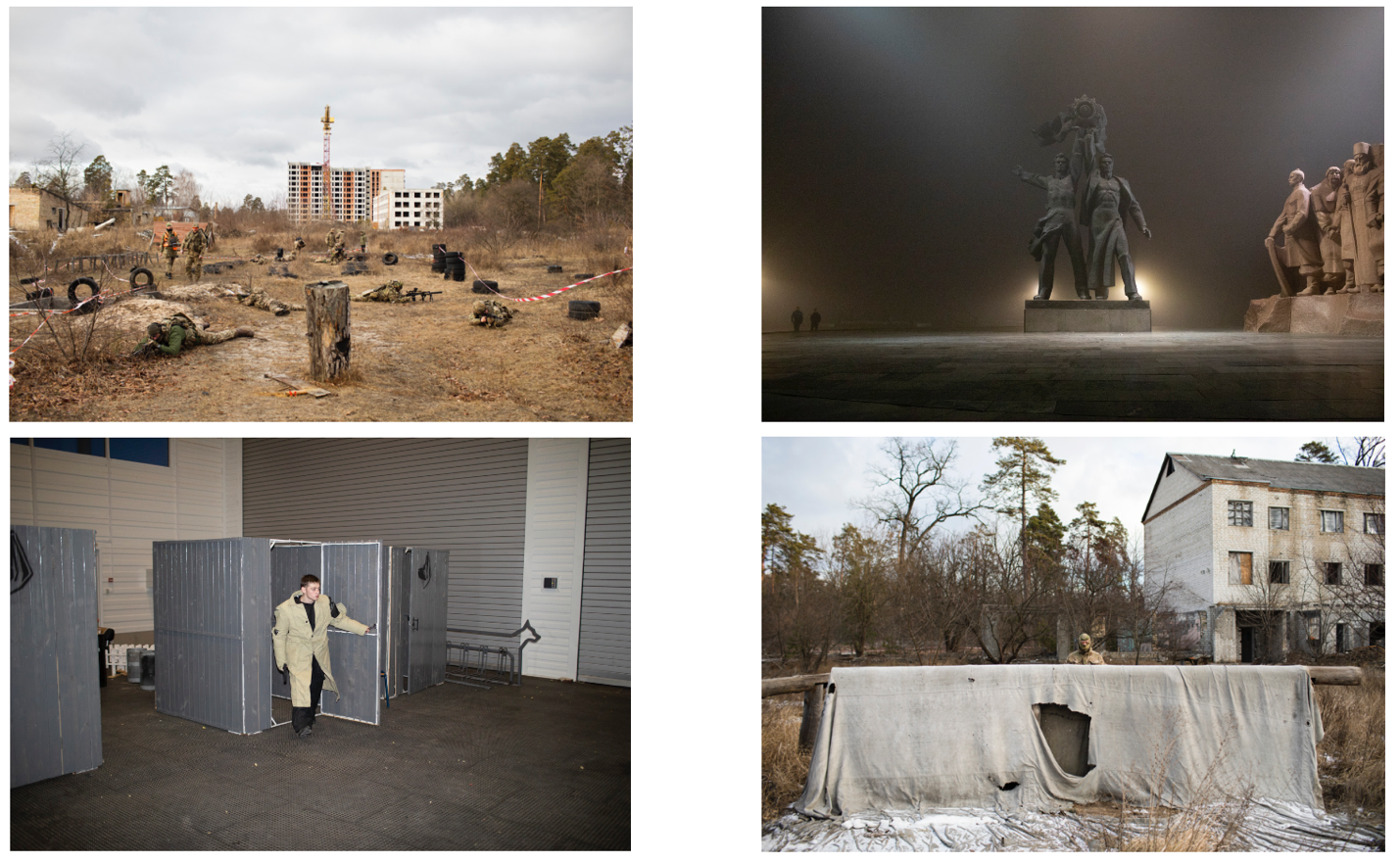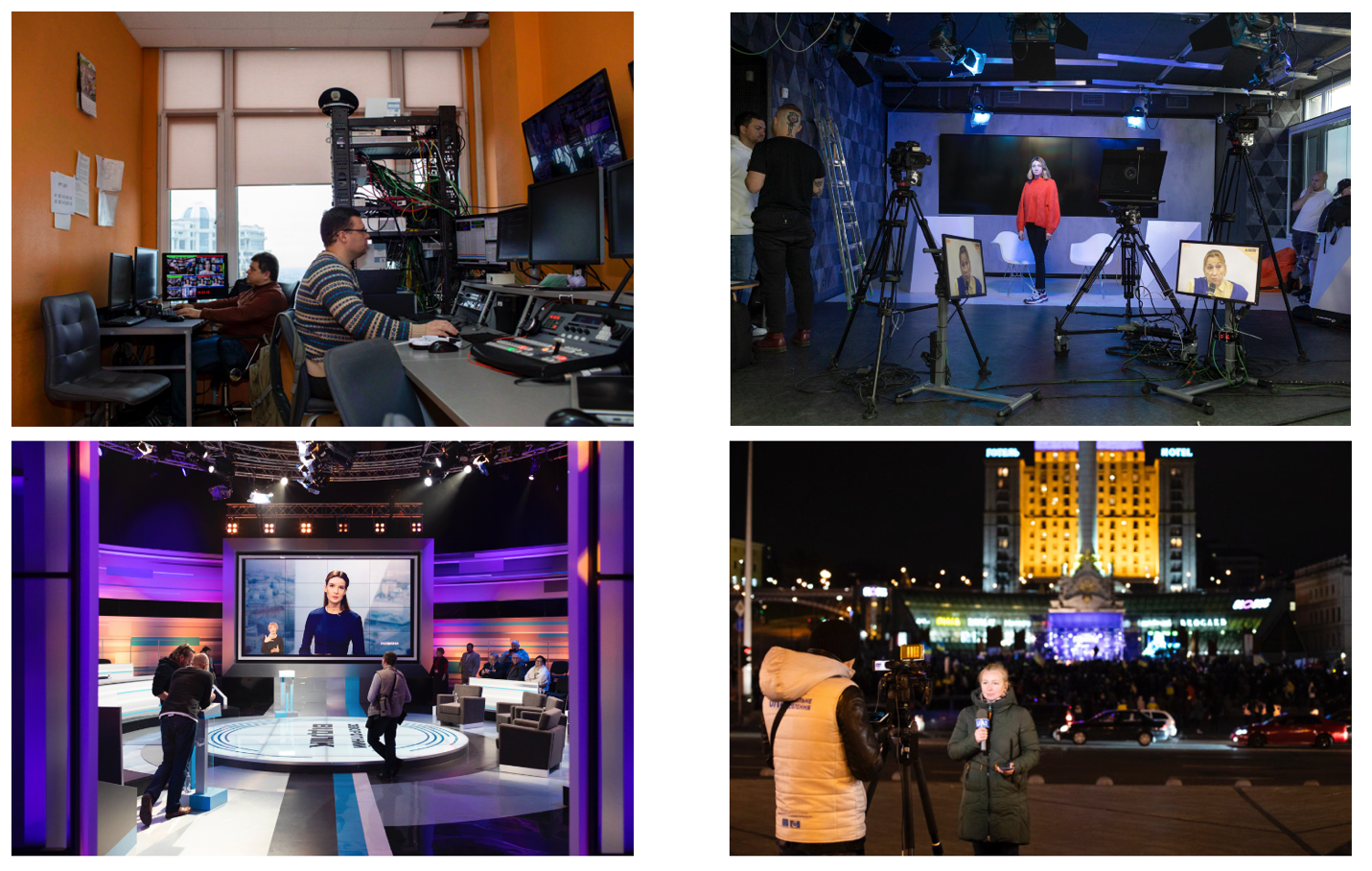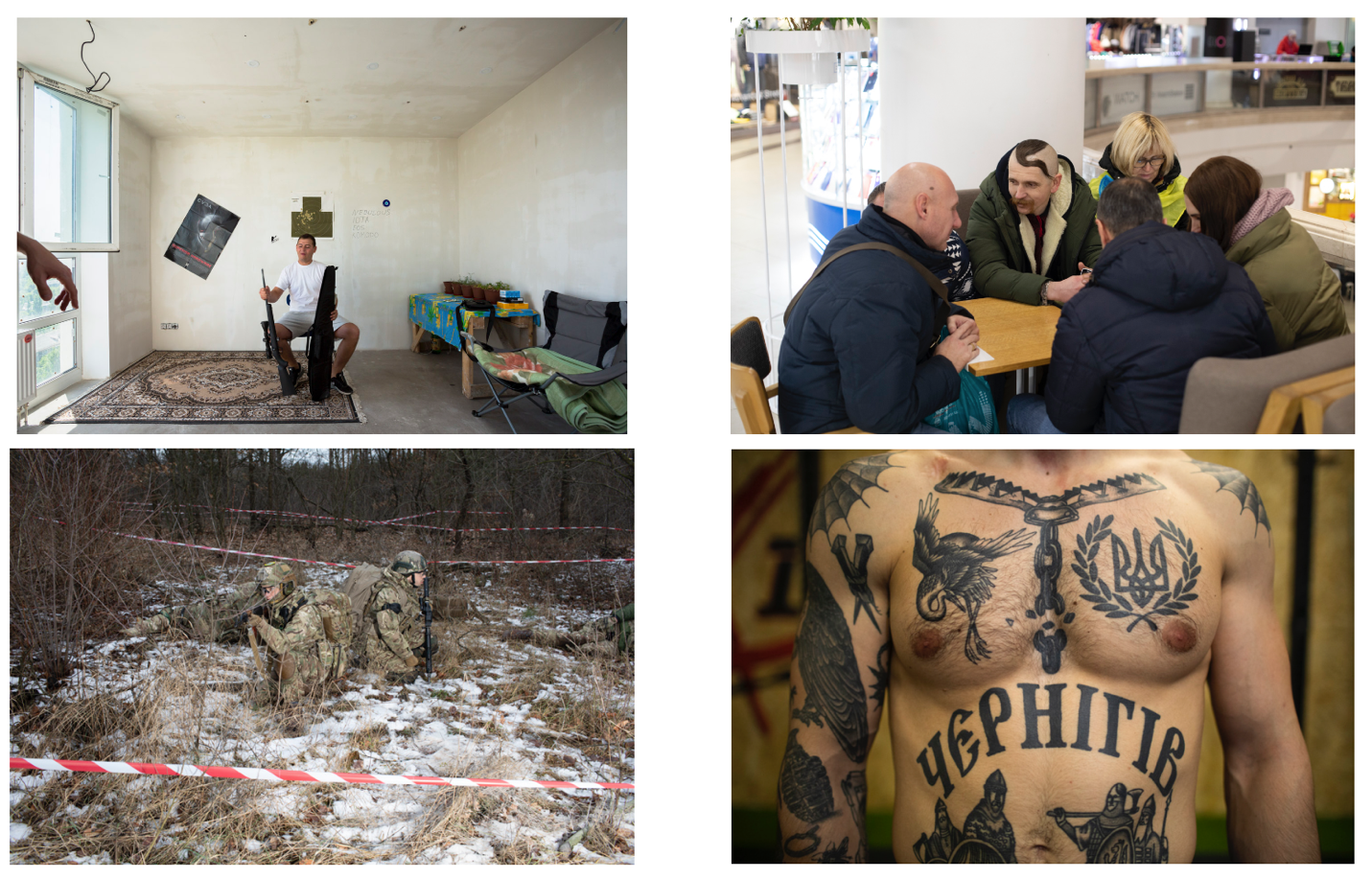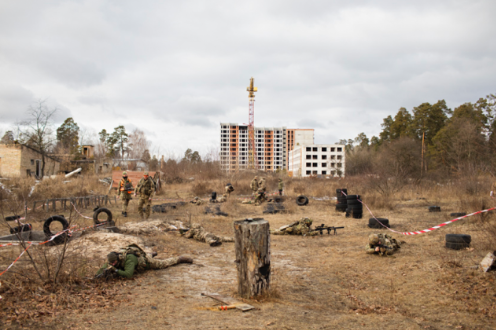War in Ukraine – an Interview with Dr Taras Fedirko
Authors: Taras Fedirko, Research Associate, Social Anthropology, University of St Andrews & Andrea E. Pia, Assistant Professor, Anthropology, London School of Economics
Date: 23/03/2022
html / PDF
ISSN 2073-4158
About
Taras Fedirko is British Academy Research Fellow at the Department of Social Anthropology, University of St Andrews. His current research focuses on political economy of war, media, and oligarchy in Ukraine.
Contact: tf68(at)st-andrews.ac.uk; Twitter: @peasantpedant
All photos are by Alexander Parkyn-Smith (copyright), documentary photographer and anthropologist, from an on-going collaborative project with Taras Fedirko.
Contents
Tell us about your recent fieldwork in Ukraine
Can you tell us a bit more about the way in which the transition from socialism affected the Ukrainian society?
What should we make of Vladimir Putin's argument that the goal of the current Russian invasion is the ‘denazification’ of Ukraine?
What role did the right-wing play in post-revolution armed mobilisation?
What was the relationship of these volunteer militias with the Ukrainian military?
Can you clarify what was in the Minsk peace agreements?
What could have Putin’s Russia, a petrostate riddled with social inequalities and heavily dependent on European imports, offered to Ukraine to swerve its local elites away from the EU?
How can we help as members of the ASA?
Abstract
In this interview, The ASA Media Officer Andrea E. Pia talks with Dr Taras Fedirko about his recent ethnographic fieldwork on militarism and media oligopolies in Ukraine. Dr Fedirko discusses the political and social contexts of Ukraine after the Maidan revolution and clarifies the role that media corporations, Putin’s propaganda, and para-military groups have played in the lead-up to Russia’s invasion of Ukraine.

Tell us about your recent fieldwork in Ukraine
I come from the west of Ukraine. Starting my PhD at Durham University in October 2013, I planned to do fieldwork in Ukraine. I had to change my plans after the Russian annexation of Crimea and the beginning of the war in Donbas in spring 2014, and only started doing field research in Ukraine in 2017. Since then, I've spent at least 18 months in Kyiv, on two separate ethnographic projects: one about the political economy of liberal media after the Maidan revolution in 2013-14, the other about the moral economy of militarism and the emergence of new war-time elites. Broadly speaking, I've been researching the post-revolutionary, war-time transformation of the Ukrainian civil society, and its changing relations with the Ukrainian state and the Euro-Atlantic powers.
My first period of fieldwork in Ukraine was with two public broadcasters that emerged in 2013-14. These are Hromadske TV, a journalist-run NGO, and the Public Broadcasting Company of Ukraine, formerly the largest state-owned broadcaster. This work helps us understand the securitization of the Ukrainian public sphere and that has occurred since 2014, and which is likely to get worse as the result of the current Russian invasion. I’ll explain. From the ethnographic vantage point of the two newsrooms, I explored professional networks that made up what I’ve called the liberal movement for the reform of the journalistic profession. This is a small but vocal, internationally connected faction of Kyiv’s journalistic community that consolidated in the early 2000s and expanded its organisational power after the 2013-14 revolution. These are people who have made it their task to openly oppose and reform the dark economy of news journalism characterised by oligarchic owners’ censorship and a pervasive form of corruption called dzhynsa: paid-for publicity and spin disguised as news. Approximately 3/4 of Ukrainian broadcast media are owned by four financial-industrial (‘oligarchic’) groups, who use news media as a lever in negotiation of political rents for their businesses in the energy and metallurgy sectors. At the same time, since the 1990s many print media outlets have sustained themselves by selling dzhynsa to clients among political and economic elites. The media reformers, but also many ordinary editors and reporters in my fieldsite, rightly claim that Ukrainian news reporting is in a moral crisis of legitimacy.
In this context, the media reform movement has advocated for collective professional control over the standards and processes of news production, in order to step up against dzhynsa and media owners’ instrumental censorship. So this is, in a sense, a movement for the freedom of speech as freedom of labour.

After 2013, rapidly increasing western funding created an opportunity for the reformist movement to cut ties with the mainstream of the profession. Reformists used grants to set up several new media outlets – among them the ones where I did my fieldwork – organised around their moral-professional vision, and explicitly opposed to the ‘corrupt’ mainstream. Many of my interlocutors in 2017-18 saw their careers in terms of the distinction between ‘real’ and ‘dishonest’ journalism. The funding that made all this possible increasingly came with new conditions: it combined the imperative of promoting liberal democracy with the new goal of opposing ‘malign Kremlin influence’ and pro-Russian disinformation. (Russia, in turn, was pursuing similar efforts at influence). This generated divisive conflicts in the media profession not only over who counted as ‘real’ journalist, but also who was ‘pro-Ukrainian’, and who, ‘pro-Russian’. This polarisation reduced the space available for critical reporting on human rights issues and crimes in the context of the war in Donbas and contributed to the efforts of successive Ukrainian governments to contain political opposition.
When President Zelensky was elected in 2019 with 73% in the run-off, with many voting for his pro-peace platform, the media reformers and allied civil society organisations found themselves in opposition to this agenda. This was a contributing — although of course not the only — factor in Zelensky abandoning that agenda (I’m simplifying here) and seeking closer ties with the nationalists and national liberals. In February 2021, Zelensky issued an executive order sanctioning several key anti-western opposition politicians such as Viktor Medvedchuk who was evidently involved in backdoor diplomacy with the Kremlin and the separatists in Donbas since 2014 and profited from questionable business deals brokered by the Kremlin. Medvedchuk also led a political party, Opposition Bloc—For Life, which was emerging as Zelensky’s main competitor for future voters. Zelensky shut down Medvedchuk’s TV channels — a move supported by G7 embassies and most liberal media reformers. The reason for which many liberal journalists supported the state crackdown on Medvedchuk’s channels (and some other outlets before and after that) was because they saw them as machines of political influence rather than real – balanced, objective – news media. They saw them as part of the ongoing information war in which Russia used misinformation and fake news to gain control of, or at least cause chaos in, the Ukrainian public sphere. It is true that at least some part of news broadcast on Medvedchuk’s channels played into Russian geopolitical interests or repeated the talking points of the Kremlin propaganda. But more broadly, labelling certain positions or outlets as pro-Russian not only helped erase Kremlin propaganda from Ukraine’s mainstream media, but also disenfranchised voices critical of Ukraine’s integration into the Euro-Atlantic order. In the context the on-going war, the liberal principle of equal of citizenship stared to give way to the friend-enemy distinction, transforming the terms and conditions of free speech.
To sum it up. Ukraine’s liberal media professionals, who sincerely believe in their cause, have been indirectly recruited as a foot soldier in the geopolitical confrontation between the US-led liberal ‘empire’, and the Russian imperialist project in East Europe. It has been increasingly more difficult for journalists to conduct their work in their own terms, without being implicated in the escalating geopolitical conflict one way or another. The war in Donbas precipitated an unprecedented securitisation of the Ukrainian public sphere since 2014, which is only going to get worse now. But it would be wrong to see these media reformers as merely pawns on a grand geopolitical chessboard, as dummies in a structural power play. It was them and people like them – Western-oriented urban intelligentsia, entrepreneurs, professionals, and managers – who explicitly made it their task to transition out of the post-Soviet condition to market liberalism and liberal democracy. They embraced this ‘transition’ as a process of explicit, engineered personal and social change, staking their careers, hopes, and notions of personal worth, on it.
Can you tell us a bit more about the way in which the transition from socialism affected the Ukrainian society?
In the anthropology of postsocialism, we have made it our task to debunk normative models that construe the ‘transition’ from state socialism to market capitalism as linear movement from A to B. And we have also predominantly focused on the losers of this transition, people displaced by the arrival of capitalist relations — a perspective which was necessary for adequate critique of the sheer violence of postsocialist social change, and which was also in tune with anthropology’s moral focus on the ‘suffering slot’. But debates about postsocialism in East Europe have largely side-lined the role of intellectuals, managers, and professionals, who embraced this transition as an explicit ethical and political project because it expanded their economic power and/or appealed to them ideologically.
The media reform movement that I have studied is a good example of a highly mobilised part of the middle class in Ukraine that has supported the transition to liberal democracy and free market as a project of modernisation. As I said, this was a bottom-up project, but not exclusively. Journalists and media development activists responded to opportunities opened by regionally available western funding, which itself is a feature of the competition of the expanding Euro-Atlantic order with Russia over influence in Ukraine. Today, Russian propaganda makes much of Ukraine being somewhat under the ‘external rule’ of the west. I don’t think that’s a correct or helpful way to think about the problem of western power in Ukraine: the causal model implied is wrong because, as far as I can tell, western geopolitical and economic power is refracted and mediated, for instance by movements such as the one I studied.
As a side note: the question of why Russian funding would be less ‘external’ is of course not raised in these Russian claims, an absence that, in and of itself, reveals an imperialist premise of the discourse. Of course, since 2014, it’s been Russia’s military, rather than its ‘soft’ power, that’s been most detrimental to Ukraine’s sovereignty. And then, Russia aside, there is the problem that we, scholars at European and American universities who have taken in various traditions of leftist thought, have always been better placed to understand and critique western imperialism in East Europe. In doing so, we have neglected both local agency and other competing imperialist projects. There’s now a vibrant conversation going on the Ukrainian Left about this at the moment, as represented by open letters from the Oxford anthropologist Volodymyr Artiukh1, or publicist and organizer Taras Bilous2. The debate has been further stirred by interventions of scholars such as David Harvey3 and Chris Hann4 (representative of a broader group on the Left in the US and Britain), whose one-sided critique of the war as essentially provoked by NATO (not even Ukraine) reveals the extent to which their perspective has been shaped by decades of US hegemony.
This first fieldwork forced me to think macro-socially: about the history of the Ukrainian political economy, and geopolitics. But it also made me appreciate how people and movements come to play decisive role in shaping these large-scale networks of power. And it led me to my second project, started in October 2021. Originally my aim was to understand how the war in Donbas had brought to the fore new elites within the civil society, creating new political alliances. By elites I mean social groups in charge of specific resources and power networks, be they managers of western-funded NGOs, or leaders of militant right-wing movements that emerged out of the fire of war. With this project, I wanted to trace how the war in Donbas changed the Ukrainian civil society, and to what extent it had, for the lack of a better term, ‘militarised’ it. Since then, the project changed somewhat: I have come to focus a lot more on the moral economy of war and militarism.
What should we make of Vladimir Putin's argument that the goal of the current Russian invasion is the ‘denazification’ of Ukraine?
That claim is nonsense, and the best way to demonstrate that is to deal head-on with the question of the Ukrainian radical right. Anthropologists’ professional trick of explaining things by getting into other people’s shoes makes me personally uncomfortable here. But explaining why the claim makes sense in the world of Putinist propaganda is not the same as saying it is factually true, nor that it can justify the invasion and bombing of civilians. For post-Soviet audiences, the symbolic charge of the trope of ‘denazification’ comes from the victory of the Soviet people and the Red Army against European fascisms in WWII, which was an important element in the self-understanding of the Soviet nation, and a cornerstone of Soviet memory politics. Up until today, this is central in Russia, and to a lesser extent in Ukraine. Fascism as enemy par excellence retained its cultural importance to the point that in 2014 it still could be mobilised by the opponents of the Maidan revolution, who declared it a ‘fascist coup’.
Nostalgic, imperialist Russian nationalism found a perfect enemy in the right-wing groups at the Maidan protests. The ‘organised-right’ was a minority among the revolutionaries, but they played a certain role once the protests turned violent. Among the leaders of the self-defence forces, and in the political and civic ‘councils' of the Maidan, there were right-wing figures — politicians, intellectuals, ex-militants — who had long advocated for an anti-Soviet version of memory politics that highlighted Ukraine’s nationalist resistance to both Soviets and the Nazis in WWII. The key groups from this historical canon, the Organisation of Ukrainian Nationalists (OUN) and the Ukrainian Insurgent Army (UPA), had also briefly collaborated with the Nazis before turning against them. They recruited from among Ukrainian Holocaust perpetrators and were involved in the ethnic cleansing of Poles in what is now north-west Ukraine. In the Soviet politics and historiography, they were squarely denounced as ‘fascist’. This was rhetorically used against the whole of the Maidan revolution and the post-Maidan government. The latter was declared illegitimate by Russia, partly on the claim that it supported the rehabilitation of the memory of OUN and UPA. Arguably this shift in cultural politics had become possible thanks to the Russian incursion in Donbas and the annexation of Crimea: the experience of eroded sovereignty, war and mass displacement mainstreamed anti-Soviet and anti-Russian sentiments that had never had nationwide relevance.
What role did the right-wing play in post-revolution armed mobilisation?
After the revolution and Russia’s annexation of Crimea and anti-Maidan protests in the south and east of Ukraine, which, with some Russian help, soon turned into separatist uprisings, some of the radical right-wing groups started to recruit militias. Others took part in street skirmishes with anti-Maidan protesters and militants. The government, weak and unable to rely on the loyalty of law enforcement forces in east Ukraine, encouraged Maidan self-defence groups to turn into pro-government militias. Among those who mobilised in this manner, nationalism of both civil and ethnic kind probably was an important shared orientation — after all, the mobilisation was a response to then very strongly felt threat of an all-out Russian invasion. The organised radical right as such was a minority, albeit an active, disproportionately visible one. This played into the Russian and anti-Maidan discourse about Ukraine’s post-revolution ‘fascism’. We must understand that the Maidan, the ensuing anti-Maidan protests, the annexation of Crimea, and the war in Donbas intensified a long-standing social conflict in the country that had been capitalised on by the elites for years, and in which socio-economic grievances were translated into the idiom of cultural and geopolitical loyalties, alternative canons of historical memory, and so on.
It bears repeating once again: organised, militant right wing were a minority in the kaleidoscopic revolutionary coalition. Had it not been for the breakout of the war in Donbas, Russia’s undeclared invasion in 2014-15, and its continued support to the rebels, this coalition would have fallen apart just as it had in 2005 after the Orange Revolution. It didn’t have a shared positive programme. Instead, the war transformed and cemented it, giving right wing militants the opportunity to exercise limited military power, and increasing the symbolic importance of their brand of nationalism. In a sense, the growth of the radical right in Ukraine since 2014 is a result of Russia’s actions.
To simplify a lot, since the beginning of the war in 2014, there has been an overall rightward shift in the mainstream public discourse. An informal political coalition has emerged: a bloc of forces, stretching from national liberals and various stripes of centrist sensibilities to the radical right, that systematically opposed the implementation of the Minsk peace accords, while otherwise sharing little by way of common political or economic programme. It is worth noting here that the Minsk agreement was significantly more favourable for Russia than for Ukraine; I explain why below. It is not least through this coalition, in which it played the role of a violent enforcer, that the militant right saw its power and voice amplified despite being a numeric minority without much formal representation in the parliament. But even though this coalition had a role in narrowing down the scope of political options for dealing with the Donbas conflict, it never defined the character of post-revolution political regime. And it was never ‘fascist' or ‘nazi’, to warrant ‘denazification’. In case there are any doubts left: none of this – if anything at all – can justify an invasion of a sovereign country
What was the relationship of these volunteer militias with the Ukrainian military?
The war in Donbas began as a series of combat operations designed to suppress armed separatists who took control of administrative buildings in Donetsk and Luhansk regions. Few units in the armed forces were combat ready, and civil society took over in two respects. On the one hand, military support activists supplemented state provisions to the military and paramilitary law enforcement units with everything from clothing to bullets, optical sights, and artillery ballistic calculation software. On the other, there were the already-mentioned volunteer battalions: autonomous pro-government militias and units (many of them formally under the command of the armed forces or law enforcement agencies), composed of volunteers and enjoying some autonomy. Commanders of several of these units were elected to parliament in 2014, when major parties sought to capitalise on their charisma.
These groups were instrumental in taking on the rebels during the initial stage of the Anti-Terror Operation, as the war was officially called then, in Spring 2014-Winter 2015. The operation was having some success towards the end of summer 2014, so much so that, to prevent Ukraine from retaking these territories, Russia increased its support to the rebels and sent in its regular armed forces in disguise. Together, they defeated the Ukrainian forces, among them many volunteers, near the city of Ilovais’k and along several other axes and forced them to retreat. The first Minsk peace accords were negotiated on the back of these defeats in September 2014. They were essentially imposed on Ukraine by a militarily superior adversary. Minsk II came in February 2015 after another series of defeats. The Minsk peace agreements dictated the ‘disarmament of all illegal groups’, which meant that the Ukrainian state moved to incorporate most volunteer units that had not yet been so incorporated, into the Armed Forces or the National Guard, where they had varying degrees of autonomy. Former volunteers I interviewed in Ukraine disliked this: many despised army’s bureaucracy and said it stood in the way of what they really wanted, that is, fighting the enemy. For some right-wing units, which were backed up by broader movements, such incorporation also threatened to undermine their power, and they more or less successfully resisted it. Others, such as the Azov Regiment which is part of the National Guard, found ways to maintain their autonomy within formal structures. Them having a broader movement capable of staging violent protest in Kyiv, was key to retaining that autonomy.
Can you clarify what was in the Minsk peace agreements?
The agreements had two parts: military and political. The military part prescribed a ceasefire and demilitarisation along the line of contact monitored by the OSCE, exchange of prisoners of war and so on. From the start of the war until autumn 2014, the theatre of war in Donbas was like a chessboard: there was no single frontline. Rebel- and government-controlled villages and positions were interspersed with one another. Despite the proclamation of the two separatists ‘people’s republics’, power in them was not centralised either and different warlords vied for the control of territory with one another. All this gradually changed. Because of the withdrawal of heavy armaments from the line of contact (mandated by the peace accords and implemented with varying success), the fighting became predominantly a position warfare. For the ensuing 7 years the war was mostly waged by infantry, unsupported by heavy artillery.
Ceasefires were declared periodically, and often violated by both sides. Ukrainian troops often were officially not allowed to initiate offensives or even respond to attacks. Some of the warfare therefore was waged informally, outside of the control of the military bureaucracy. From the perspective of ex-combatants I interviewed, the use of unaccounted-for munitions; deployment of volunteers in unofficial operations; use of civilian drones dropping DIY bombs on enemy lines and so on, was a necessary response to the actions of the Russia-backed separatists who, for instance, used ceasefires and demilitarisation as cover for moving their positions forward. All in all, among the pro-government combatants, the peace accords were perceived as a ploy to constrain them while giving military advantage to Russia-backed separatists. Dissatisfaction with the peace accords was also widespread among national-liberal intelligentsia and other groups, including the media.

Still, the military part of the agreements was more successful that the political one. The political part of Minsk II mandated local elections in the rebel-held territories; pardon and amnesty to combatants; constitutional reform and decentralization of the Ukrainian state providing for a certain autonomy of the rebel-held regions; it also included restoration of the state control of the border with Russia in the rebel-held territories. The implementation of these provisions was met with strong resistance from nationalist political elites, pro-Western civil society, and the militant right. Up until Russia’s recognition of the rebel republics just before the invasion, which formally killed the Minsk peace process, the parties to the agreements could not agree on the order of the political steps.
If implemented, the political part of Minsk would have ensured that the Ukrainian state could not join NATO or implement some other form of foreign policy detrimental to the Russian state. Arguably, that was the goal of Russia in fuelling this war in the first instance. We must remember that the Maidan protests were triggered by President Yanukovych’s rejection of the EU Association Agreement in favour of closer ties with Russia. The elites brought to power by the revolution reversed that and pursued Ukraine’s integration into the Euro-Atlantic order. The war in Donbas, then, was a means for Russia to achieve its political ends in Ukraine, namely slow down or reverse this integration. The current invasion is no different. It backfired then, and it has backfired now, too.
What could have Putin’s Russia, a petrostate riddled with social inequalities and heavily dependent on European imports, offered to Ukraine to swerve its local elites away from the EU?
Russia and the broader Eurasian Customs Union it leads offered a major market for Ukraine’s steel, railway carriages, and other product of heavy industries. Donetsk and Luhansk regions proved a fertile ground for anti-Maidan protests because there was material basis for supporting closer economic ties with Russia. These areas were the industrial core of Ukraine, even if the machinery was degraded and productive capacity cannibalised by decades of underinvestment. In these regions workers would have gained little, in the short run, from being more directly integrated into the European markets. Political scientist Yuri Zhukov, for instance, has argued that municipalities in Donbas ‘more exposed to trade shocks with Russia experienced a higher intensity of rebel violence throughout the conflict’5. He suggests that ethnolinguistics identities offer a worse explanation for the bottom-up support for the separatists in 2014. His explanation has been contested, but I think it’s an important part of the picture. At the same time, we did not see significant, open support for separatists among the economic elites controlling these industries in Donbas. Still, these major players resisted post-Maidan political reforms introduced on Western behest, which could have undermined their capacity to extract rent. To the extent there was support for the separatists among regional elites in East Ukraine, it came from local politicians and middle ranks of state bureaucracies, who stood to lose from the change of power in Kyiv and the ensuing geopolitical turn, and perhaps gained from the unrest.
How can we help as members of the ASA?
There are several ways to help. First, we should support the humanitarian and relief work with our money, our skills, and in kind, such as by hosting Ukrainian refugees. I’d urge ASA members to donate. Small, Ukrainian-run organisations, appear more agile, but also more informal, in distributing aid. Large international organisations, such as the Red Cress and Caritas, are more systematic at needs assessment, and because of their status operate where smaller, local initiatives cannot6. People with links in Ukraine and the broader region, in countries to where refugees are arriving, should consider gathering donations and transferring money directly to their contacts in need. Anthropologists Elizabeth Cullen Dunn, Deborah Jones, Anastastia Piliavsky, and Natalia Roudakova, who are channelling donations directly to individuals and families, and helping refugees with transport, are an example for all of us. Those willing to donate directly can get in touch with them or me on institutional email, and we’ll coordinate. We should also use the organisational power that our universities give us. So many institutions aspire to global leadership; now is the time to fill that slogan with some sense, for example by getting universities to fundraise for Ukraine across their philanthropic and alumni networks, and by having them offer in-kind services, such as free language classes, CV writing sessions, and career advice to refugees. We should pressure senior management to make this happen, and to adopt this as standard practice for all refugees regardless of provenance.
Second, we should push our universities to not only to host established scholars from Ukraine, but to offer funded emergency admissions to Ukrainian students; and establish non-residential scholarships for Ukrainian academics and non-academic researchers and cultural workers unable or unwilling to leave Ukraine. UK universities should also be pushed to help their Ukrainian students and precarious staff who are in danger of having to leave the UK. This can include directing hardship funds towards students, reducing or cancelling student accommodation fees, and offering free summer stays. Zero-hours staff from Ukraine should be offered secure contracts so that they can support themselves and their families in Ukraine, while short-term contract staff should have their contracts extended. UCL and the University of St Andrews are successful examples of such advocacy: in both cases, the universities and the local University and College Union branches have agreed to direct significant sums from the retained strike pay from the most recent wave of industrial action towards fellowships for displaced Ukrainian scholars.
Finally, we have some responsibilities to our scholarly community. Historically, British social anthropology had little interest in Ukraine. This has improved somewhat since the beginning of the war in 2014, but the situation is still dire. Because of the war, we might not be able to do much research in Ukraine for the foreseeable future, but we must be creative about how to continue the work about the in order to build up a community of scholars capable of maintaining informed, critical conversations on Ukraine. I also don’t know what is going to happen to PhD students or early career researchers who were planning to go to Russia, but I hope they manage to get the institutional support they need for their projects, because more than ever we need to understand what is going on there as well.
We need to keep a non-sectarian debate, which is open to perspectives from Ukraine and from Russia, but is also critical, objective to the extent it is possible. This is very difficult for me personally because I'm deeply affected by the war: some members of my family have left the country because of the fighting; my friends and research participants have taken up arms. To many of them, detached scholarly objectivity in the context of war looks like treason.
Footnotes
2 https://commons.com.ua/en/letter-western-left-kyiv/
4 https://www.focaalblog.com/2022/03/11/chris-hann-the-agony-of-ukraine/


